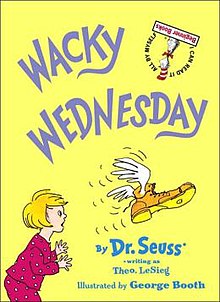
Theodor Seuss Geisel was an American children's author and cartoonist. He is known for his work writing and illustrating more than 60 books under the pen name Dr. Seuss. His work includes many of the most popular children's books of all time, selling over 600 million copies and being translated into more than 20 languages by the time of his death.

The Cat in the Hat is a 1957 children's book written and illustrated by American author Theodor Geisel, using the pen name Dr. Seuss. The story centers on a tall anthropomorphic cat who wears a red and white-striped top hat and a red bow tie. The Cat shows up at the house of Sally and her brother one rainy day when their mother is away. Despite the repeated objections of the children's fish, the Cat shows the children a few of his tricks in an attempt to entertain them. In the process, he and his companions, Thing One and Thing Two, wreck the house. As the children and the fish become more alarmed, the Cat produces a machine that he uses to clean everything up and disappears just before the children's mother comes home.
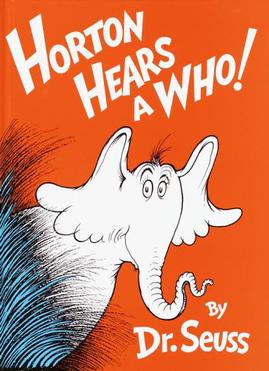
Horton Hears a Who! is a children's book written and illustrated by Theodor Seuss Geisel under the pen name Dr. Seuss. It was published in 1954 by Random House. This book tells the story of Horton the Elephant and his adventures saving Whoville, a tiny planet located on a speck of dust, from the animals who mock him. These animals attempt to steal and burn the speck of dust, so Horton goes to great lengths to save Whoville from being incinerated.

Green Eggs and Ham is a children's book by Dr. Seuss, first published on August 12, 1960. As of 2019, the book has sold 8 million copies worldwide. The story has appeared in several adaptations, starting with 1973's Dr. Seuss on the Loose starring Paul Winchell as the voice of both characters, and more recently an animated TV series of the same name on Netflix.

Marvin K. Mooney Will You Please Go Now! is a 1972 children's book by Dr. Seuss. Written as a book for early beginning readers, it is suitable for children who can not yet read at the level of more advanced beginning books such as The Cat in the Hat. The book presents, in short and funny fashion, Dr. Seuss's nonsensical words, rhymes, and illustrations.

The Butter Battle Book is a rhyming story written by Dr. Seuss and published by Random House on January 12, 1984. It is an anti-war story: specifically, a parable about arms races in general, mutually assured destruction and nuclear weapons in particular. The Butter Battle Book was a New York Times Notable Book of the Year.

'And to Think That I Saw It on Mulberry Street' is Theodore Seuss Geisel's first children's book published under the name Dr. Seuss. First published by Vanguard Press in 1937, the story follows a boy named Marco, who describes a parade of imaginary people and vehicles traveling along a road, Mulberry Street, in an elaborate fantasy story he dreams up to tell his father at the end of his walk. However, when he arrives home, he decides instead to tell his father what he actually saw—a simple horse and wagon.

Yertle the Turtle and Other Stories is a picture book collection by Theodor Seuss Geisel, published under his more commonly known pseudonym of Dr. Seuss. It was first released by Random House Books on April 12, 1958, and is written in Seuss's trademark style, using a type of meter called anapestic tetrameter. Though it contains three short stories, it is mostly known for its first story, "Yertle the Turtle", in which the eponymous Yertle, king of the pond, stands on his subjects in an attempt to reach higher than the Moon—until the bottom turtle burps and he falls into the mud, ending his rule.

Thidwick the Big-Hearted Moose is a 1948 children's book by Dr. Seuss.

If I Ran the Zoo is a children's book written by Dr. Seuss in 1950.

Hop on Pop is a 1963 children's picture book by Dr. Seuss, published as part of the Random House Beginner Books series. The book is subtitled "The Simplest Seuss for Youngest Use", and contains several short poems about a variety of characters designed to introduce basic phonics concepts to children.
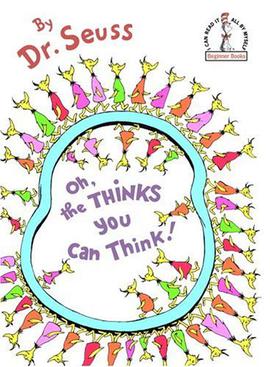
Oh, the Thinks You Can Think! is a children's book written and illustrated by Theodor Geisel under the pen name Dr. Seuss and published by Random House on August 21, 1975. The book is about the many amazing 'thinks' one can think and the endless possibilities and dreams that imagination can create. The book's front cover depicts forty-seven unknown creatures walking around on a cyan circle.
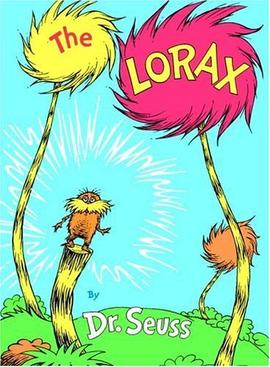
The Lorax is a children's book written by Dr. Seuss and published in 1971. It chronicles the plight of the environment and the Lorax, the main character, who "speaks for the trees" and confronts the Onceler, a business magnate who causes environmental destruction.

Beginner Books is the Random House imprint for young children ages 3–9, co-founded by Phyllis Cerf with Ted Geisel, more often known as Dr. Seuss, and his wife Helen Palmer Geisel. Their first book was Dr. Seuss's The Cat in the Hat (1957), whose title character appears in the brand's logo. Cerf compiled a list of 379 words as the basic vocabulary for young readers, along with another 20 slightly harder "emergency" words. No more than 200 words were taken from that list to write The Cat in the Hat. Subsequent books in the series were modeled on the same requirement.

In Search of Dr. Seuss is a 1994 American television film chronicling the adventures of a news reporter, Kathy Lane, who enters the world of Dr. Seuss by opening a magical book. Also starring in the film were Matt Frewer, Christopher Lloyd, Andrea Martin, David Paymer, Patrick Stewart, Andraé Crouch, Robin Williams, and Eileen Brennan.
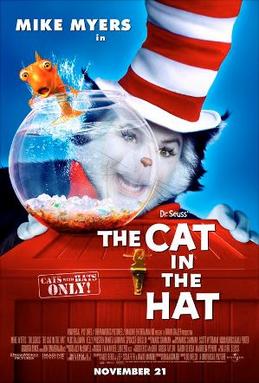
The Cat in the Hat is a 2003 American fantasy comedy film directed by Bo Welch in his directorial debut and written by Alec Berg, David Mandel and Jeff Schaffer. Loosely based on Dr. Seuss's 1957 book of the same name, it was the second and final live-action feature-length Dr. Seuss adaptation after How the Grinch Stole Christmas (2000). The film stars Mike Myers in the title role along with Alec Baldwin, Kelly Preston, Dakota Fanning, Spencer Breslin, Amy Hill and Sean Hayes in supporting roles.
Theodor Seuss Geisel, better known as Dr. Seuss, published over 60 children's books over the course of his long career. Though most were published under his well-known pseudonym, Dr. Seuss, he also authored over a dozen books as Theo. LeSieg and one as Rosetta Stone.
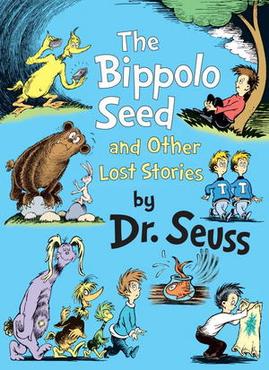
The Bippolo Seed and Other Lost Stories is a collection of seven illustrated stories by children's author Dr. Seuss published by Random House on September 27, 2011. Though they were originally published in magazines in the early 1950s, they had never been published in book form and are quite rare, described by the publisher as "the literary equivalent of buried treasure". The stories were discovered by Charles D. Cohen, a Massachusetts dentist and a Seuss scholar and biographer, who also wrote an introduction to the collection.

The political messages of American children's author and cartoonist Theodor Seuss Geisel, best known as Dr. Seuss, are found in many of his books. Seuss was a liberal and a moralist who expressed his views in his books through the use of ridicule, satire, wordplay, nonsense words, and wild drawings to take aim at bullies, hypocrites, and demagogues.
Dr. Seuss's ABC, otherwise referred to as The ABC, is a 1963 English language alphabet book written by Dr. Seuss starring two anthropomorphic yellow dogs named Icabod and Izzy as they journey through the alphabet and meet characters whose names begin with each letter. It was read as an audiobook by British comedian Rik Mayall as part of the 2000 audio release The Dr Seuss Collection.
